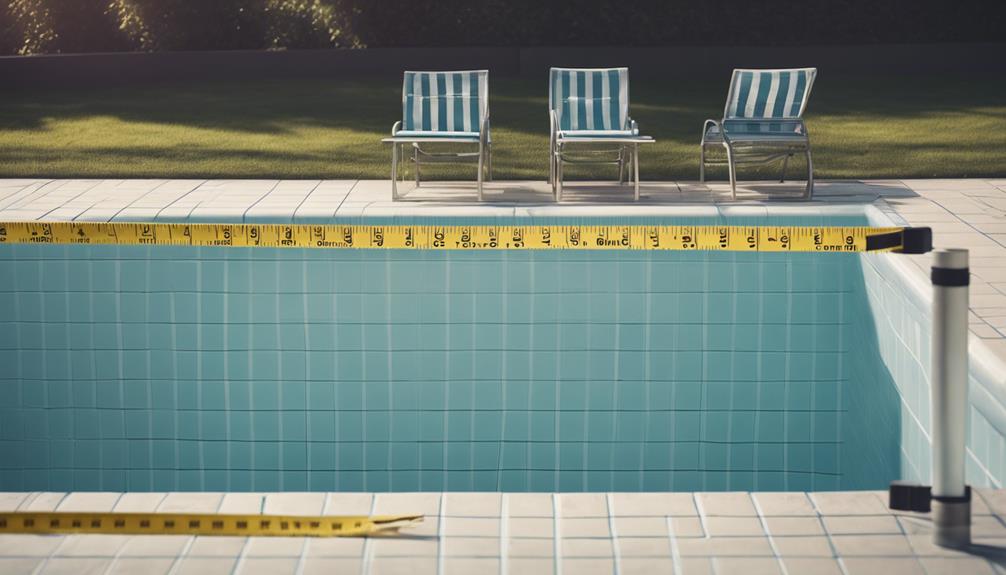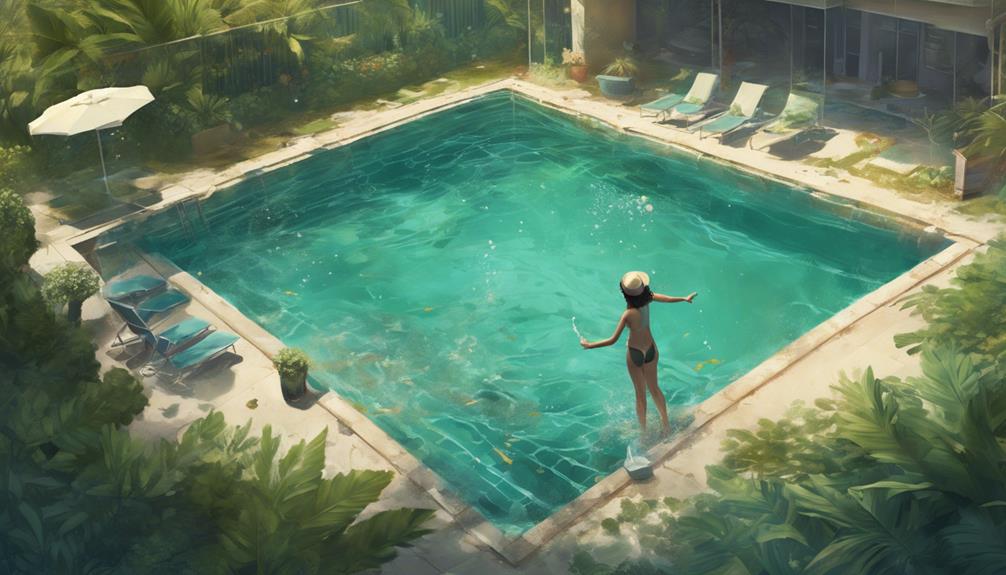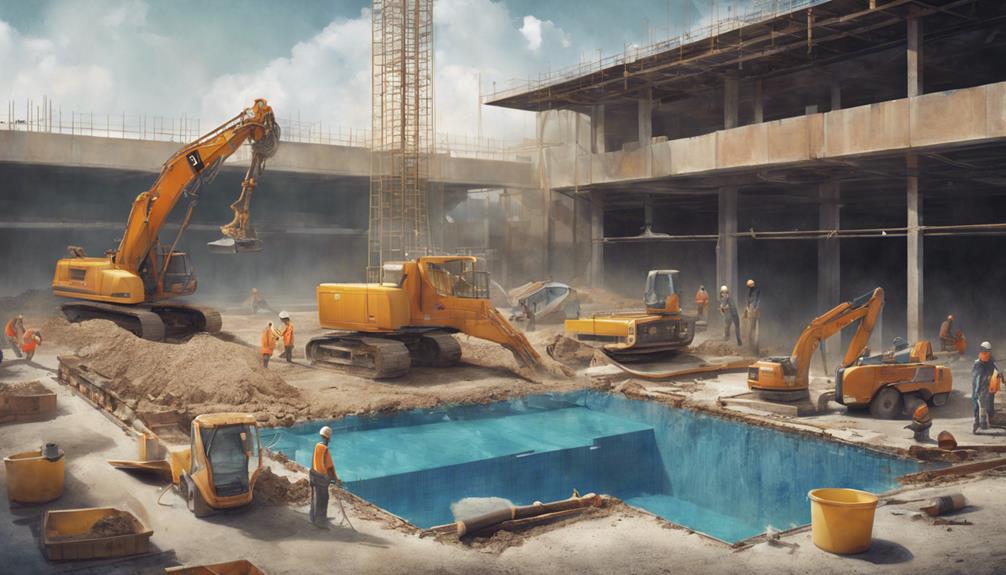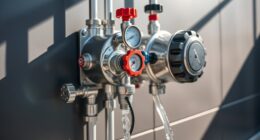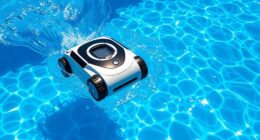To accurately determine the area of your swimming pool, start by measuring the length, width, and depth with precision. Use geometric formulas that are suitable for your pool shape to calculate the surface area. It is important to find the average depth to ensure correct volume calculations for maintenance and chemical balance. It is crucial to follow a regular maintenance schedule using proper cleaning tools such as skimmers and vacuums to maintain water clarity and ensure swimmer health. Understanding these measurements is essential for creating a safe and enjoyable swimming environment. Additional steps can be taken to further optimize your pool maintenance routine.
Key Takeaways
- Measure pool length, width, and average depth accurately for precise area calculations.
- Utilize geometric formulas like length x width for rectangular pools and πr^2 for circular pools.
- Regular maintenance ensures accurate chemical dosages and water balance for a safe swimming environment.
- Follow a maintenance schedule including skimming, vacuuming, and equipment inspections for optimal pool upkeep.
- Routine maintenance prevents algae growth, maintains water clarity, and ensures a safe swimming environment.
Selecting Pool Shape
When choosing the shape of your swimming pool, consider various options like round, oval, rectangular, lazy L, Roman, and kidney bean designs. The pool shape plays a significant role in both the aesthetics and functionality of your pool. Different shapes can impact the swimming experience and the overall look of your outdoor space. It's essential to select a pool shape that not only fits your design preferences but also suits the available space you have for installation.
Furthermore, specific measurements such as pool length, width, and depth are important for accurate calculations of the pool's surface area and volume. Accurate measurements guarantee that you have the right information to maintain and treat your pool effectively.
Gathering Pool Measurements

Consider starting your pool project by measuring the dimensions of your pool accurately to determine its surface area. Proper measurements are essential for understanding the area of your swimming pool, which influences maintenance needs and chemical usage. Here is a table outlining the key measurements required based on the shape of your pool:
| Pool Shape | Measurements Needed |
|---|---|
| Rectangular | Length, Width |
| Circular | Diameter |
| Oval | Length, Width, Depth |
| Irregular | Break down into simpler shapes |
Ensuring precise measurements for irregularly shaped or kidney bean pools might involve breaking them down into simpler geometric shapes. By obtaining accurate measurements, you pave the way for calculating the area effectively. This step sets the foundation for the subsequent calculations and decisions regarding pool maintenance, making it an essential starting point in your pool project.
Measuring the Pool

Measuring your pool accurately is essential for determining its surface area and planning maintenance effectively. Start by measuring the depth using a tape measure from the bottom to the top of the pool wall. If there's variation in depth, record the minimum and maximum depths.
To find the average depth, add the shallow end's depth to the deepest point's depth and divide by 2. Remember, accurate depth measurement is vital for calculating the surface area of the pool.
By understanding the pool's shape and depth, you can plan maintenance and chemical treatments more efficiently. This information not only helps in maintaining the pool but also ensures the correct amount of chemicals are used, saving you time and money in the long run.
Calculating Surface Area

To accurately determine the surface area of your swimming pool, utilize the appropriate formula based on the pool's shape and dimensions. Measure the distances carefully and follow these steps:
- Use the Correct Formula: Different pool shapes require specific formulas for surface area calculation. Make sure you use the formula that corresponds to your pool's shape – be it rectangular, circular, oval, or irregular. This step is important in obtaining an accurate surface area measurement.
- Convert Measurements: Before plugging the values into the formula, make certain all measurements are in the same unit. Consistency in units is vital for precise calculations.
- Utilize a Calculator: To streamline the process and avoid calculation errors, consider using a surface area calculator. These tools can provide convenience and accuracy in determining your pool's surface area.
- Depth and Multiplication: Remember that pool depth plays a significant role in the surface area calculation. Measure the depth accurately and multiply it by the perimeter or radius, depending on the pool's shape, to include this dimension in your final calculation.
Determining Pool Depth

When determining the pool depth, accurately measure from the bottom to the top of the pool wall in feet using a tape measure. It's important to record both the minimum and maximum depths of the pool to guarantee precise calculations.
To find the average depth, add the shallowest and deepest points together and then divide by two. Understanding the depth of the pool is essential for planning maintenance tasks and determining the correct chemical dosages.
Knowing the actual water depth helps in calculating the pool's volume and surface area accurately. By obtaining precise measurements, you can ensure that your pool maintenance and treatment efforts are effective and efficient.
Applying Geometric Formulas

Understanding how to effectively apply geometric formulas is essential for accurately calculating the area of your swimming pool. By utilizing the correct formulas based on the shape of your pool, you can guarantee precise measurements for maintenance and chemical treatment purposes.
Here are some key points to keep in mind when applying geometric formulas to determine your pool area:
- Know Your Pool Shape: Different pool shapes require specific geometric formulas for accurate area calculations.
- Utilize Correct Formulas: Use formulas like A = L x W for rectangles, A = πr^2 for circles, and specialized formulas for irregular shapes like ovals.
- Break Down Complex Shapes: If your pool has irregular shapes, break them down into simpler geometric shapes to facilitate accurate area calculations.
- Ensure Accuracy: Calculating the pool area correctly is vital for determining chemical requirements, equipment sizing, and overall maintenance needs.
Calculating Pool Volume
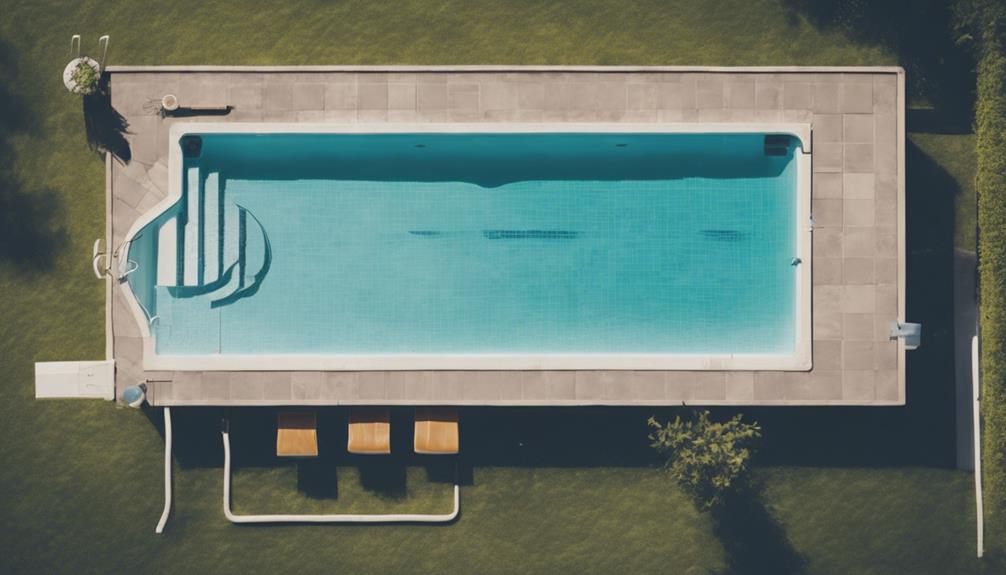
For important pool maintenance, calculating the volume of your swimming pool is vital in determining chemical dosing and equipment sizing.
To calculate the volume, consider the shape of your pool.
For rectangular pools, multiply the length, width, and average depth by 7.5 gallons per cubic foot.
Circular pools require using the formula: radius squared x 3.14 x average depth x 7.5 to determine the volume in gallons.
When dealing with oval pools, multiply the length, width, and average depth by 3.14/4 and 28.31 to find the volume in liters.
Irregularly shaped or kidney pools can be calculated by multiplying specific measurements by .45, the average depth, and 28.31 for volume in liters.
Accurate volume calculations are essential for proper chemical dosing, filter and pump sizing, and cover fitting.
Understanding Pool Maintenance

To properly maintain your swimming pool, it's essential to balance the water chemistry, ensuring a safe and healthy environment for swimmers.
You'll need specific cleaning tools such as brushes, nets, and vacuums to keep the pool surface free of debris and algae.
Establishing a routine maintenance schedule will help you stay on top of tasks and prevent costly repairs in the future.
Pool Water Balance
Maintaining proper pool water balance involves keeping pH levels within the range of 7.2-7.6, total alkalinity between 80-120 ppm, and calcium hardness between 200-400 ppm.
To guarantee your pool water is in its best condition, follow these key steps:
- Regular Testing: Test your pool water frequently using a reliable kit to monitor pH, alkalinity, and calcium hardness levels.
- Adjustments: Make necessary adjustments by adding pH increaser or decreaser, alkalinity increaser, or calcium hardness increaser to maintain the ideal balance.
- Chlorine Levels: Keep chlorine levels between 1-3 ppm to effectively sanitize your pool and prevent the growth of harmful bacteria.
- Prevention Measures: Conduct shock treatments every 1-2 weeks, maintain proper filtration and circulation, and prevent algae growth to ensure crystal-clear water.
Cleaning Tools Needed
You'll want essential cleaning tools like a skimmer, brush, vacuum, and chemical testing kit for proper pool maintenance. These tools are crucial for keeping your pool in top condition. Skimming the surface helps to remove debris, while brushing prevents algae buildup, and vacuuming eliminates dirt and sediment that can accumulate on the bottom. Regular cleaning not only maintains water clarity but also reduces the need for excessive chemical usage and prevents algae growth.
When selecting cleaning tools, consider the size of your pool. Calculate the square feet of the pool's surface area and take into account the depth of the shallow end. Different pool shapes may require specific tools to effectively clean hard-to-reach areas.
Routine Maintenance Schedule
Understanding the routine maintenance schedule for your swimming pool is essential for ensuring a clean and safe swimming environment. Regular upkeep not only enhances water quality but also extends the lifespan of your pool equipment.
To effectively maintain your pool, follow these key steps:
- Skim and Vacuum: Regularly skim the pool surface to remove debris and vacuum the pool floor to prevent buildup, ensuring crystal-clear water.
- Chemical Balance: Test and adjust the pool's chemical levels to prevent algae growth and maintain water clarity, safeguarding swimmers' health.
- Filter and Equipment Check: Clean or replace filters as needed, and inspect pool equipment for any malfunctions to prevent costly repairs.
- Consistent Schedule: Establish a routine maintenance schedule to promote proper circulation, filtration, and sanitation, creating a pleasant and safe swimming environment for all users.
Frequently Asked Questions
How Do You Calculate the Area of a Swimming Pool?
To calculate the area of a swimming pool, you must use the appropriate formula based on its shape, like rectangular or circular. Make sure all measurements are in the same unit before applying the formula for accurate results. Correctly measuring the pool's dimensions is essential for precise area calculation.
The pool's surface area impacts the needed pool finish, chemical requirements, and system sizing for heating and filtration. Regularly monitoring changes in the surface area is important for efficient pool maintenance.
What Is the Formula for a Swimming Pool?
To calculate the surface area of a swimming pool, different formulas are used based on the pool's shape. Rectangular pools use the formula: 2lw + 2lh + 2wh.
Circular pools have their own formula: 2πr² + 2πrh.
Oval pools have a unique formula: πab + (a + b)√((a – b)² / 4 + h²).
For irregular shapes, breaking them down into simpler shapes allows for accurate area calculations.
Accurate area calculations are essential for determining pool finish, chemical needs, and maintenance system sizing.
How to Find the Area of a Rectangular Pool?
To find the area of a rectangular pool, multiply the length by the width in feet. Confirm that both measurements are in the same unit (feet) before multiplying to get an accurate result.
Knowing the pool's area aids in determining the amount of finish, chemicals, and heating needed. Rectangular pools are commonly used and easy to calculate for maintenance and renovations.
Trust this straightforward formula for accurate area calculations every time.
What Is the Surface Area of a Pool That Is 50 Feet Long and 25 Feet Wide?
To find the surface area of a pool that's 50 feet long and 25 feet wide, multiply the length by the width. In this case, the surface area is 1250 square feet.
Knowing these dimensions is essential for accurate calculations and proper pool maintenance.
Understanding the pool's surface area at 1250 square feet helps in making decisions about finishing, heating needs, and choosing the right filtration system for best pool functionality.
How Does Measuring the Swimming Pool Length Help in Finding the Area of the Pool?
Measuring swimming pool length accurately is crucial for finding the area of the pool. By measuring the length and then multiplying it by the width, you can easily calculate the total area of the pool. This helps in determining the amount of water needed to fill the pool and also aids in maintenance and cleaning.
How Can I Calculate the Area of a Swimming Pool in Order to Book the Right Size at MBS?
To accurately book a swimming pool at MBS, you need to calculate the area of the pool. Measure the length and width, then multiply these dimensions to get the square footage. This will help you determine the right size of the pool to book swimming pool at MBS for your needs.
Can I Use the Same Method to Calculate the Area of the Swimming Pool at MBS?
Yes, you can use the same method to calculate the area of the swimming pool at MBS. By referencing the book swimming pool MBS, you can find the dimensions and use the formula for the area of a rectangle to determine the total area of the pool.
Can I Use the Same Method to Calculate the Area of a Swimming Pool at MBS?
Yes, you can use the same method to calculate the area of a swimming pool at MBS. When booking swimming pool MBS, it’s important to know the exact dimensions of the pool to ensure you have enough space for your needs. Using the same method for calculation will provide accurate results.
Conclusion
To sum up, accurately measuring the area of your swimming pool is crucial for proper maintenance and care. By following the steps outlined in this guide, you can guarantee that your pool stays in top condition and avoid any potential issues down the line.
Remember, taking the time to calculate the surface area and volume of your pool won't only assist with maintenance but also contribute to a more enjoyable swimming experience for you and your family.

